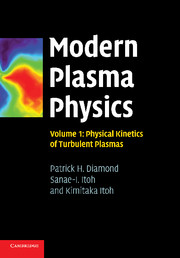Book contents
- Frontmatter
- Contents
- Preface
- Acknowledgements
- 1 Introduction
- 2 Conceptual foundations
- 3 Quasi-linear theory
- 4 Nonlinear wave–particle interaction
- 5 Kinetics of nonlinear wave–wave interaction
- 6 Closure theory
- 7 Disparate scale interactions
- 8 Cascades, structures and transport in phase space turbulence
- 9 MHD turbulence
- Appendix 1 Charney–Hasegawa–Mima equation
- Appendix 2 Nomenclature
- References
- Index
Preface
Published online by Cambridge University Press: 05 October 2010
- Frontmatter
- Contents
- Preface
- Acknowledgements
- 1 Introduction
- 2 Conceptual foundations
- 3 Quasi-linear theory
- 4 Nonlinear wave–particle interaction
- 5 Kinetics of nonlinear wave–wave interaction
- 6 Closure theory
- 7 Disparate scale interactions
- 8 Cascades, structures and transport in phase space turbulence
- 9 MHD turbulence
- Appendix 1 Charney–Hasegawa–Mima equation
- Appendix 2 Nomenclature
- References
- Index
Summary
The universe abounds with plasma turbulence. Most of the matter that we can observe directly is in the plasma state. Research on plasmas is an active scientific area, motivated by energy research, astrophysics and technology. In nuclear fusion research, studies of confinement of turbulent plasmas have lead to a new era, namely that of the international thermonuclear (fusion) experimental reactor, ITER. In space physics and in astrophysics, numerous data from measurements have been heavily analyzed. In addition, plasmas play important roles in the development of new materials with special industrial applications.
The plasmas that we encounter in research are often far from thermodynamic equilibrium: hence various dynamical behaviours and structures are generated because of that deviation. The deviation is often sufficient for observable mesoscale structures to be generated. Turbulence plays a key role in producing and defining observable structures. An important area of modern science has been recognized in this research field, namely, research on structure formation in turbulent plasmas associated with electromagnetic field evolution and its associated selection rules. Surrounded by increasing and detailed information on plasmas, some unified and distilled understanding of plasma dynamics is indeed necessary – “Knowledge must be developed into understanding”. The understanding of turbulent plasma is a goal for scientific research in plasma physics in the twenty-first century.
The objective of this series on modern plasma physics is to provide the viewpoint and methods which are essential to understanding the phenomena that researchers on plasmas have encountered (and may encounter), i.e., the mutually regulating interaction of strong turbulence and structure formation mechanisms in various strongly non-equilibrium circumstances.
- Type
- Chapter
- Information
- Modern Plasma Physics , pp. xi - xivPublisher: Cambridge University PressPrint publication year: 2010



